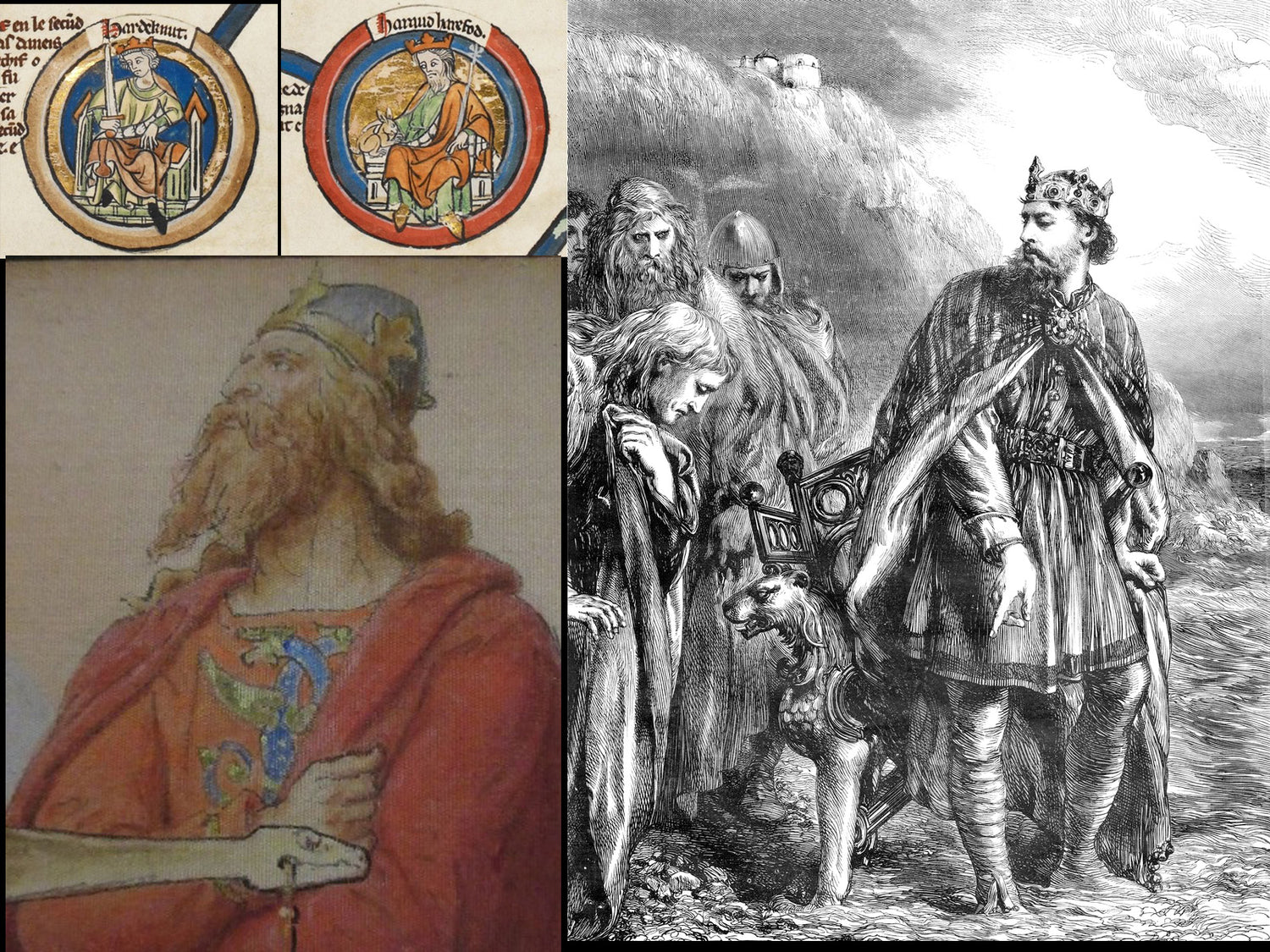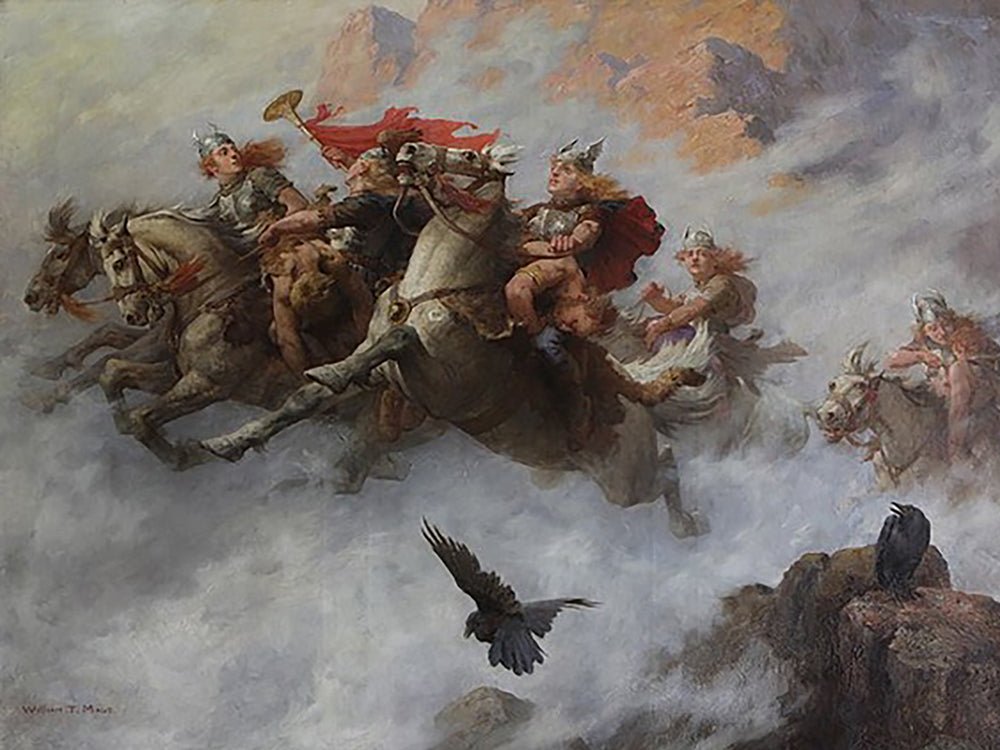The Vikings were an influential presence in England for hundreds of years, but never did they hold more power than between 1013 and 1042, when the Danish Jelling Dynasty sat on the English throne. During this period of power struggles, instability and societal change, the four Viking kings of England left an indelible mark on the country’s history. From the audacious conquest of Sweyn Forkbeard, to the spiteful rule of Harthacnut, the story of England’s Danish kings is a tale of ambition, reform, opportunism and vengeance, without which Britain would not be the same today.
Sweyn Forkbeard: The First Viking King of England

Sweyn Forkbeard was born into a Denmark where change and expansion were ubiquitous. His father, Harold Bluetooth, was the first Viking ruler to embrace Christianity as his kingdom’s official religion, and also that kingdom to unseen heights. By the time Sweyn reached adulthood, his father’s lands stretched from German to Norway, with satellite states as far-afield as modern-day France and Lithuania.
But Sweyn was not the loyal son and heir that a Nordic king would hope for. Sweyn was a dedicated follower of the Norse faith and disagreed with his father’s efforts to spread Christianity in Denmark. In the mid-980s, Sweyn led the pagan mercenary Jomsvikings in an uprising against his father, ultimately seizing the throne for himself. Unfortunately, he did not get to enjoy his time as King of Denmark, being sent into exile by Bluetooth’s German allies. The next 14 years Sweyn spent primarily in Scotland, during which time Denmark was occupied by Sweden. Forkbeard returned to reclaim his land, before launching several naval campaigns to sure-up his territories in Norway.
In 1002, Sweyn turned his attention across the North Sea, where King Æthelred the Unready had recently ordered the massacre of thousands of Danes on English soil. In retaliation, the Danish king authorised 12 years of relentless raids on the English coast before invading the country altogether in 1013. Beginning in Sandwich, his army stormed through the south of England, arriving to besiege London and force King Æthelred to flee. Sweyn Forkbeard proclaimed himself King of England on Christmas Day 1013.
Despite being the first Viking king of England, Sweyn Forkbeard was also the shortest reigning, dying from apoplexy just five weeks after assuming the throne. Upon his death he split his kingdoms between his two sons, leaving the English crown to Cnut…
Cnut the Great: The Diplomat King

The English had never accepted Sweyn Forkbeard as their king and were not thrilled by the prospect of his son inheriting the throne. They invited Aethelred back to retake his crown, who arrived from Normandy with a formidable army ready to defeat Cnut in battle. Instead of fighting over the English throne, Cnut decided to return to Denmark.
Cnut’s homegoing was short lived. With his ambitions still firmling across the North Sea, in 1015 he launched a massive fleet of ten thousand Vikings in 200 longships to reconquer his lost kingdom. Over the next few months, Cnut’s men swept across England, devastating the local armies set to stop them. Chief among his victories was the Battle of Assandun in October 1016, at which Cnut defeated Aethered’s son Edmund Ironside and took all of England apart from Wessex. When Edmund died just a few weeks later, Cnut became king of Wessex too at the invitation of the English witan.
At first, Cnut ruled with an iron fist. He was intent on laying the foundations for a lasting dynasty of Danish kings in England, and thus set about taking estates from Englishmen and giving them to his loyal Viking followers. He had Edmund’s two sons exiled, and with them anyone who was deemed loyal to the old king.
Though he’s often unfairly remembered as a harsh and arrogant ruler, throughout his reign Cnut showed himself to be an excellent statesman and diplomat. He fostered close ties with other kingdoms in Europe through marriage and diplomacy, and brokered favourable deals allowing the English to trade and travel extensively throughout Europe. Unlike his father who had rejected Christianity, Cnut was also a generous patron to the Church and close ally to the Holy Roman Empire.
Harold Harefoot: The Unstable Regent

Cnut the Great’s succession was a complicated affair, as two of his sons, one legitimate and one illegitimate, had ambitions for the English throne. Cnut named his son Harthacnut as his heir. Harthacanute was legitimate and more widely accepted in England given his mother was the widow of Æthelred the Unready. However, he was in Denmark when his father died, and unable to take the English throne because otherwise engaged in holding back invading Norwegians.
Harold Harefoot, Cnut’s illegitimate son by his mistress Ælfgifu, decided that he would use his brother’s absence to stake his claim to the throne. The witenagemot in Oxford agreed to grant him the crown until his brother arrived, making him regent. He was crowned, like all English kings, by the Archbishop of Canterbury, however, the Archbishop refused to use the ceremonial regalia. In response, Harold said that he would not go to Church and would revert to the traditional Nordic faith until he was crowned properly.
Harold’s short rule was beset by instability and insubordination by the English noblemen, many of whom didn’t see him as the rightful king. He spent most of his reign fighting to secure his position on the throne: quashing rebellions and exiling or executing opponents to the crown. He had his stepmother, Emma of Normandy, first imprisoned and then exiled, and blinded and killed one of her sons by King Æthelred.
In 1040, Harold died in Oxford aged just 24. Though the cause of his death is unknown, it’s recorded by English monks who despised Harefoot that God finally punished him by striking him down with a sudden, painful illness.
Harthacnut: The Last Danish King of England

Though proclaimed the heir to the English throne, Harthacnut spent most of his childhood outside of England. His father had sent him to Denmark aged just eight years old to learn the arts of warfare and diplomacy. At the time, Cnut’s North Sea empire was the second largest in Europe, but it was at risk of collapse due to unending challenges and invasions by Norway and Sweden. When he died, Harthacnut chose to stay in Denmark rather than lay claim to the English crown, fearing that he might lose his empire’s heartland were he to leave.
Harthacnut was furious that Harold had stolen his crown, and his rage continued to grow as he watched Harefoot oppress his mother and kill his half-brother, Alfred. Harthacnut prepared to invade England. Having signed a treaty with Norway, he amassed an impressive naval fleet to overthrow his brother. Harold Harefoot died before Harthacnut set sail, but the Danish still chose to take his fleet to English to claim the throne, hoping that this display of power would quiet any noblemen who were loyal to his brother.
Harthacnut ascended the throne without resistance and was crowned in Canterbury Cathedral with the full ceremony. As king, his first order of business was to have Harold exhumed, beheaded and thrown in a river. He then went on to try any noblemen who had been complicit in Alfed’s murder. Though he’d been greeted at Sandwich as the rightful king, Harthacnut’s short reign proved unpopular. He didn’t trust his English earls so ruled tyrannically. His tax regime saw the English paying astronomical fees to their local lords, promoting riots in Worcester at which two tax collectors were killed. King Harthacnut’s reasonable response was to burn the city to the ground.
When Harthacnut died suddenly at a friend’s wedding (possibly by stroke, possibly by poison) he didn’t have any sons to inherit the throne. His Norman half-brother Edward the Confessor stepped up to take the crown, thus ending the Jelling Dynasty and becoming the last Danish king of England.




